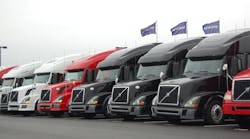The heavy-duty used truck market mostly likely reached its “peak sales” moment back in the first half of 2015, as used truck values are now declining somewhat as larger inventories begin to build, according to Steve Clough, president of Arrow Truck Sales, Inc.
“The 2011 models are the ones now coming into the used truck market in large volumes, especially over the last four to five months,” he explained during a conference call with reporters hosted by Stifel Capital Markets. “Along with the 2012/2013 models just now hitting the market, it virtually guarantees a supply increase [of used trucks] for the next several years.”
Clough stressed that used truck supply is mainly driven by the number of new trucks sold three to five years ago – and 2011 through 2013 are years when production of new trucks, especially Class 8 models, began rising significantly.
According to Arrow’s numbers, new Class 8 retail sales topped 171,000 units in 2011, increasing to 195,000 in 2012 before dipping slightly to 185,000 in 2013.
And used truck inventories will only continue to grow as Class 8 trucks sold in 2014 and 2015 begin to be traded in or come off of leases; years when retail sales topped 220,000 and an estimated 262,000 units.
“The used truck market can be very volatile and is driven by demand,” Clough noted. “So the one thing we don’t know right now is what freight demand going forward will look like – will it be strong enough to help absorb this extra supply?”That increase in used truck supply is also going to put more pressure on pricing, he added, noting that the market is experiencing about a 10% to 12% adjustment in used truck values since the first half of the year.
“But it’s not as if [used truck] prices move unilaterally; that depends on the model and what’s in demand,” Clough pointed out. “But used truck inventory is going up across the board around the country.”
He noted, however, that some interesting trends are now taking shape in terms of what truck specs are more in demand – especially when it comes to automated manual transmissions (AMTs).
Clough explained that in the used truck market, manual transmissions typically came with a “premium” in the past, as manual gearboxes were what used truck buyers wanted.
“But now we’re seeing much more demand for AMTs,” he pointed out. “They are not being accepted equally across the [used truck] market, but we’ve got a lot of ‘pockets’ of demand where customers come in and want an AMT now, even specific brands [of AMTs]. That’s quite a change from five years ago, when demand for AMTs was very rare. Over the last year or two we’ve seen a whole lot more demand for them.”
Other trends Clough noted in his analysis of the used truck market:
- Used truck buyers remain slow to adopt natural gas trucks as total natural engine life expectancy is still uncertain. “Those engines haven’t been out there long enough; we don’t have data on that yet,” he said. “The market must also find a way to solidify demand for them on the new truck side first.”
- Demand remains strong for both Class 8 daycab and sleeper tractor configurations.
- Trucks equipped with Cummins engines are not commanding a premium.
- Higher horsepower engines – 500 hp or more – are seeing a slow yet steady decrease in demand. “There are still a number of buyers who want such engines, but more are finding that higher horsepower is no longer the ‘end all, be all’ of performance,” Clough said.
- More financing companies are getting into the used truck market. “It’s becoming a more crowded space as [financing] companies look to increase yield,” he explained. “This trend goes in cycles. But right now we’ve seen the most financing options available since the beginning of the recovery.”
- OEM market share in the used truck field continues to mirror their share in new truck sales. “If one OEM commands 30% to 35% market share in new trucks, it’s about the same in the used market,” Clough noted.




